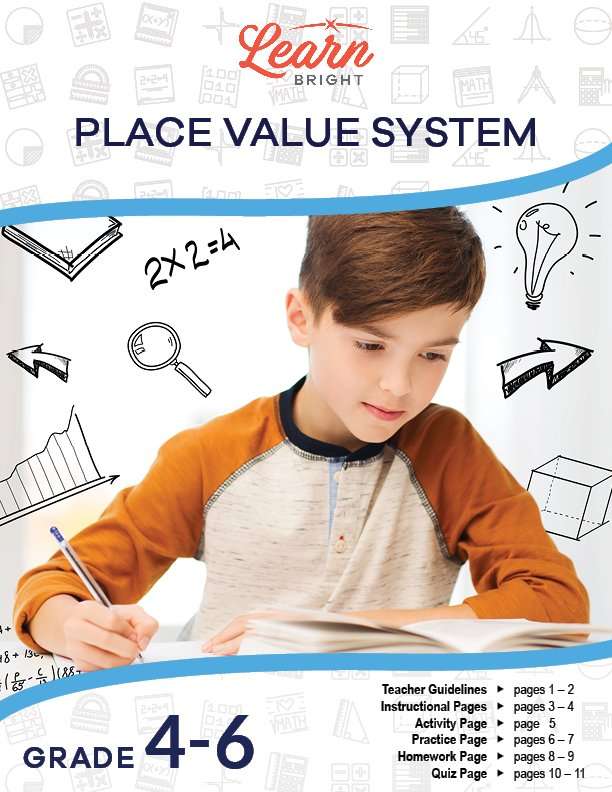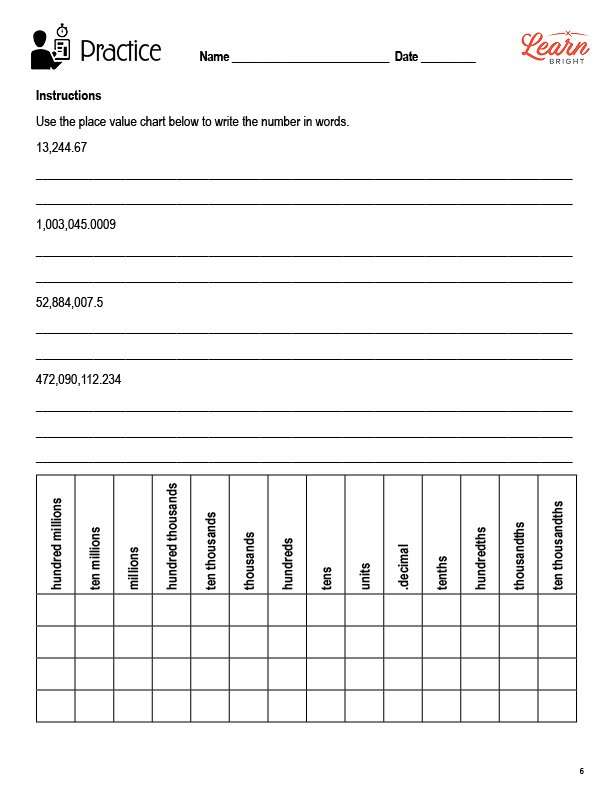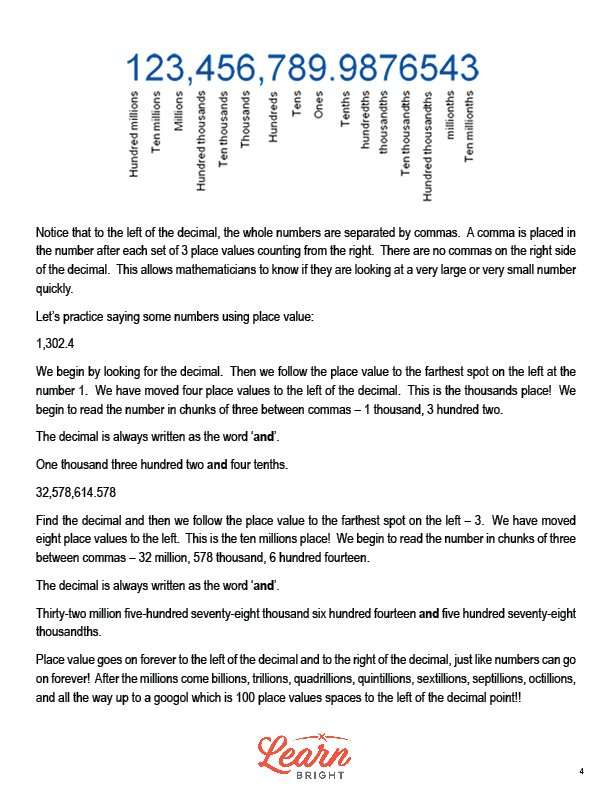Description
What our Place Value System lesson plan includes
Lesson Objectives and Overview: Place Value System teaches students to read and write numbers using place values with rational numbers. Students also learn about decimals and how they can change the value of a series of numbers. This lesson is for students in 4th grade, 5th grade, and 6th grade.
Classroom Procedure
Every lesson plan provides you with a classroom procedure page that outlines a step-by-step guide to follow. You do not have to follow the guide exactly. The guide helps you organize the lesson and details when to hand out worksheets. It also lists information in the orange box that you might find useful. You will find the lesson objectives, state standards, and number of class sessions the lesson should take to complete in this area. In addition, it describes the supplies you will need as well as what and how you need to prepare beforehand. The supplies you will need for this lesson are markers or crayons, thick paper, scissors, pins, and the handouts. To prepare for this lesson ahead of time, you can gather the materials and copy the handouts.
Options for Lesson
Included with this lesson is an “Options for Lesson” section that lists a number of suggestions for activities to add to the lesson or substitutions for the ones already in the lesson. All of the optional additions for this lesson are for the group activity. One of these additions is to have students work in small groups to create both the largest and smallest possible numbers out of the members of their group. You could also do the same with the whole class, making sure to write down both numbers. Additionally, you could have one student represent the decimal point and insert themselves into a number in a random place. Finally, you could have students bring in a plain white t-shirt and have them all decorate them with their numbers for the activity.
Teacher Notes
The teacher notes page includes a paragraph with additional guidelines and things to think about as you begin to plan your lesson. This page also includes lines that you can use to add your own notes as you’re preparing for this lesson.
PLACE VALUE SYSTEM LESSON PLAN CONTENT PAGES
Place Value System
Our Place Value System lesson plan includes two content pages. The lesson begins by stating that there are ten symbols, the numbers 0 through 9, that make up every number. We create numerals by combining these digits. The number of digits in a number determines how big that number is. The ten digits are 1, 2, 3, 4, 5, 6, 7, 8, 9 and 0. We determine the value of a number based on where we place the digits. We call this place value, which is the place or position of a number. It determines the value of the number.
In the United States, we use a number system called the Standard System or Base-10 System, as each place represents ten times the value of the place to its right. Place value is important because it tells you the value or meaning of the digits in a number. For example, the number 2 on its own represents 2 ones or 2 units, and the number 6 represents 6 ones or 6 units. You can combine these numbers to create either 26 or 62. 26 is two tens and six ones, while 62 is six tens and two ones. These numbers are so different because of the place value system. The lesson includes another example of this using 4 and 5, which can create either 45 or 54 depending on which number is in which place.
Each place value has a name. The lesson includes a helpful chart that shows the values of each place from the ten millionths to the hundred millions. There are also names and place values for the places below one, after the decimal place. Each of the places is ten times less than the place to its left. Above zero, or to the left of the decimal place, we separate whole numbers using commas. We don’t use commas on the right side of the decimal, however. Commas are useful for quickly understanding the size of a large number.
The lesson next discusses how to say large numbers based on place value. For example, the lesson uses the number 1,302.4. To figure out how to say this number, you can start with the decimal. There are four places to the left of the decimal, which is the thousands place. We always write or say decimals as the word “and.” The number in this example is written as one thousand three hundred two and four tenths. The lesson then goes over another larger example: 32,578,614.578!
Finally, the lesson notes that place value continues forever both to the right and the left of the decimal. Numbers can go on forever! After millions, you have billions, trillions, quadrillions, quintillions, sextillions, septillions, octillions, and more! Eventually, you come to a googol — 100 place values to the left of the decimal point.
PLACE VALUE SYSTEM LESSON PLAN WORKSHEETS
The Place Value System lesson plan includes four worksheets: an activity worksheet, a practice worksheet, a homework assignment, and a quiz. You can refer to the guide on the classroom procedure page to determine when to hand out each worksheet.
WE MAKE A NUMBER ACTIVITY WORKSHEET
Students will work as a class to complete the activity. Each student will pin a digit from 0 to 9 to their shirt. Students can decorate their numbers if they’d like. You will ask random groups of students to come to the front of the room and another student will read the full number created by the students standing at the front of the room. You’ll do this several times, with a different number of students each time. As the teacher, you can also represent a decimal point, and insert yourself into the number the students are making to change the value of the number. Discuss how the number changes with your students. If you’d like, you can also have students write down each number that their peers make.
WORDS PRACTICE WORKSHEET
For the practice worksheet, students will use a place value chart to write specific numbers in words. For example, they will write the numbers 13,244.67 as “thirteen thousands, two hundred forty four and sixty seven hundredths.” They will then write these numbers in a provided place value chart.
WRITE A NUMBER HOMEWORK ASSIGNMENT
The homework assignments asks students to complete a few different types of problems. First, they will write numbers with a specific number of digits in both words and numerals. Next, they will state the place value of each digit in a large number. They must also answer the question, “Why is place value important in math?”
PLACE VALUE SYSTEM QUIZ
For the quiz, students will answer a series of questions about place value. They will have to identify the place value and value of various digits. This quiz will test students’ understanding of the lesson material.
Worksheet Answer Keys
This lesson plan includes answer keys for the practice worksheet, the homework assignment, and the quiz. If you choose to administer the lesson pages to your students via PDF, you will need to save a new file that omits these pages. Otherwise, you can simply print out the applicable pages and keep these as reference for yourself when grading assignments.









